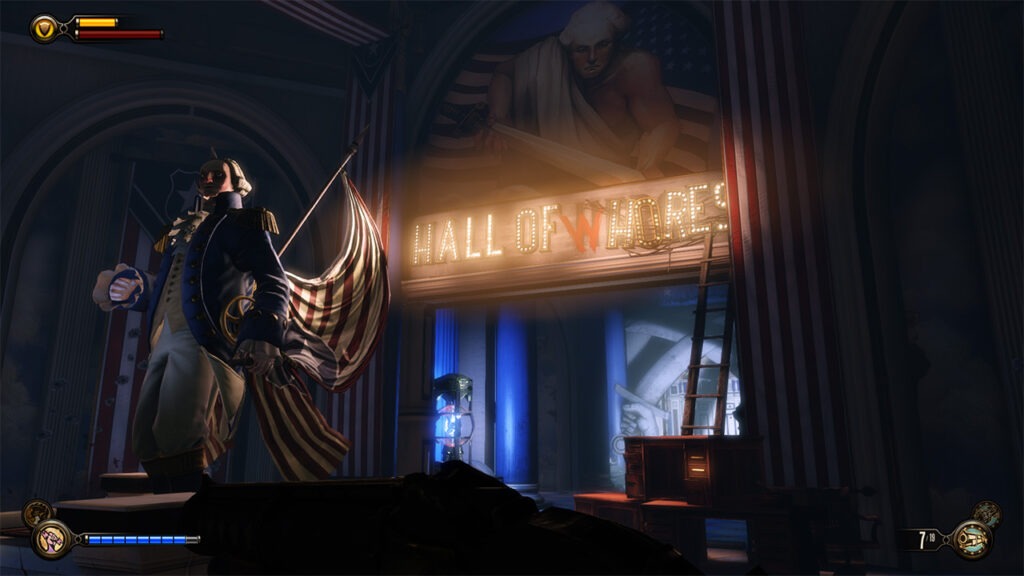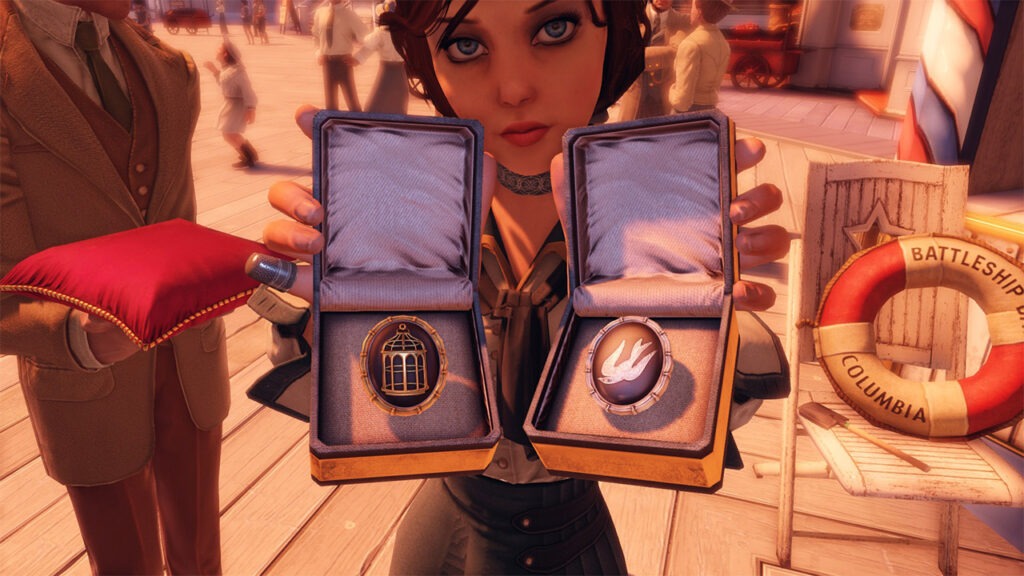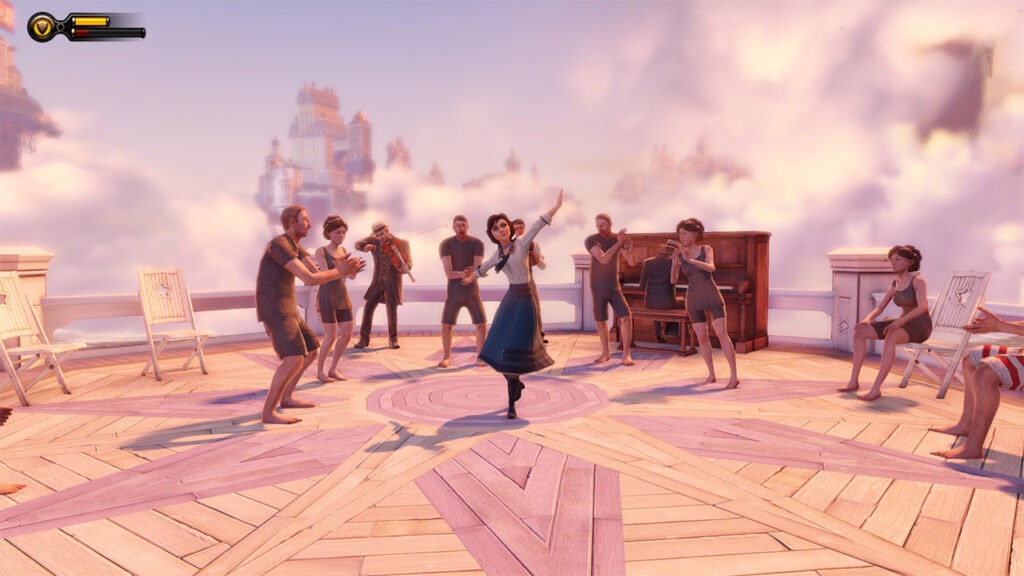Last time in The Vault, we played Prey and drew parallels between Arkane’s hidden gem and Irrational Games’ iconic BioShock. Having talked so much about the original BioShock, I missed the incredible world-building, the stunning scenery, and the top-tier narrative of the BioShock series. And that’s how I decided to give BioShock Infinite a go.
Up to now, I had only played the first game in the series. That’s almost criminal behavior, I know. BioShock games can be somewhat hard to swallow though. They fascinate you so much with their great world and the complex social messages they relay, that it is difficult to move quickly to another game. You have to take your time to fully appreciate it. So, long after my first BioShock playthrough, I felt it was time to take a look at BioShock Infinite.
The mastermind behind the first BioShock game, Ken Levine, continues his work on Infinite. Surprisingly, BioShock 2, which brings The Rapture chapter to a close, is not his work. Having skipped (both me and Levine) a title in the series, he had accumulated enough fresh ideas to create something as special as the magical world of Rapture. So, let’s walk towards the lighthouse, strap ourselves in the chair, and ascend to the city that flies above the clouds.
The flying city

Bizarre worlds is the name of the game for BioShock. Whether it’s a big city at the bottom of the sea or a flying state, you know you’re about to sink into an incredibly well-made imaginary universe. There is a reason why BioShock is unanimously considered a masterpiece and Levine one of the few auteurs in the gaming industry. In fact, for many, BioShock and Rapture are the reason why gaming can be considered a valid form of art.
It’s BioShock, but better
Columbia follows in the footsteps of Rapture, but often in the opposite direction. It is an exotic, bizarre world but instead of being submerged in the ocean, we find ourselves above the clouds. Infinite conveys deep social messages, not (always) against capitalism, but against social discrimination and religious-centered societies. BioShock Infinite takes the basic BioShock formula and turns it up a notch.
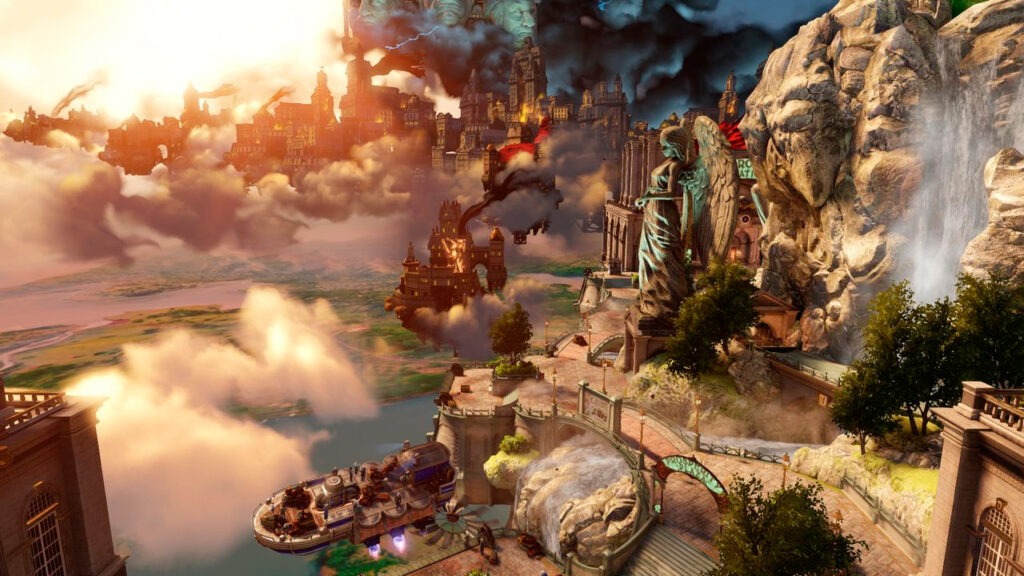
In the first BioShock game, Rapture was empty, or at least it had no living inhabitants. All you saw was the remnants of a prosperous society. In Columbia, you see great class differences and the indignation of the poorest citizens. You see racial discrimination, the exploitation of people of color by white people. In fact, you help them to revolt against their tyrants. Your actions have a lasting impact on the city. The city is not static, but an interactive environment, which you can actively influence. Compared to BioShock Infinite’s Booker, Jack from the original BioShock looks like a mere visitor in Rapture.
BioShock Infinite’s unique art design
Of course, Infinite could not be a worthy successor to BioShock without the imposing scenery. Impressive architecture, one-of-a-kind art design. Unforgettable character models, who make the characters just as memorable as their personalities do. It’s impossible to see a snapshot of this game and not straight-up understand which game it comes from. It is a masterful pairing of the steampunk style combined with the American Patriotic theme and various divine or heroic forms. The result is truly awe-inspiring.
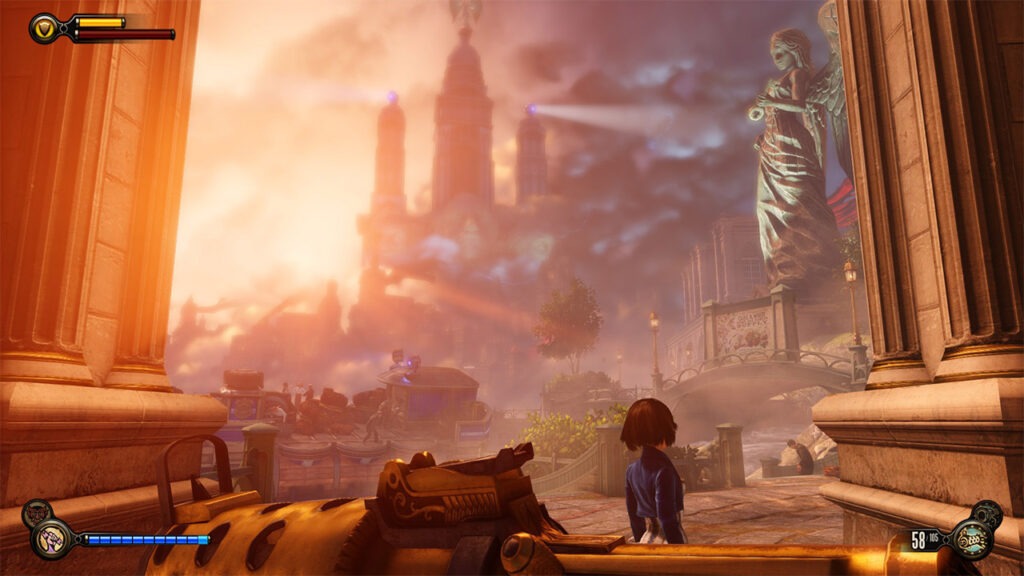
The key to Columbia’s personality is the city’s architecture. The in-game sets draw inspiration from real buildings and take the Infinite art design twist. Columbia is truly a magical world, at first glance. But the underlying messages are what set the tone perfectly for the deeper story told by BioShock Infinite. Just like Rapture, Columbia is in a way one of the characters in the story. The city is one of the main storytelling pillars.
Art design plays a major part in Infinite’s storytelling
Columbia begins as the depiction of the ideal state, free from the shackles of earthly life. When you set foot in the city, you are overwhelmed by messages about how awesome life is up there. Soon, however, you realize everything is but a facade. The economic and social elite are living in their pink bubble, disconnected from reality. What’s really happening is far from the what you first see. Citizens are largely oppressed, captives of a theocratic regime. People of color are slaves. Infinite is not afraid to address issues such as social differences and blind faith in a higher power, long before any of these became meta-themes. And all this, with no restraint. Levine does not pull any punches. Infinite puts the cruelty of these issues on full display.
Source: Gaming Rebellion
BioShock Infinite is essentially presented as a fairy tale. The world is absolutely fantastic, and you are immersed in a magical adventure. Allegories are widely used here. A flying city, a princess imprisoned in a castle by a crazy king with a giant robot bird guarding it. Like a Disney fairy tale, gone wrong.
The plot
The beautiful scenery and the underlying messages are enough for most people to fall in love with the Infinite’s world. And yet, that’s just the tip of the iceberg. Infinite tells another, equally enchanting story. In true BioShock fashion, it all starts with a lighthouse.
Booker DeWitt, Infinite’s protagonist, is a former detective (mostly mercenary I’d say) who worked with the Pinkerton agency. “Bring us the girl and wipe away the debt”, is a phrase that we will hear very often in this game. That’s the phrase with which two mysterious figures drop us of at the lighthouse that will take us to Columbia. In the flying city, we have to find the girl who lives in a tower, cut off from the rest of society.

Once we set foot in Columbia, we will almost immediately be branded as the number one Public Enemy. The Prophet, the religious leader of Columbia will do everything in his power to prevent us from approaching the tower. After fighting hordes of enemies, slowly but steadily, we reach our destination.
The enchanting Elizabeth
Elizabeth is initially presented as a parallel to Disney’s princesses. Trapped in a tower all alone, she spent her time studying the outside world until the hero came to her rescue and they dived nose first into an intense adventure. All fine and dandy, until you discover that while she was locked up there, those that kept her locked up, conducted weird experiments on here. And because of that, she can open portals to other dimensions. She has a very tragic backstory as a character. And yet, Elizabeth is the “glue” that holds Infinite together.
Source: Gaming Rebellion
The animators did an amazing job and Elizabeth has awesome facial expressions, especially in the Remastered version I played. But Courtnee Draper, who brings the character to life with her voice, steals the show here. The conversations between her and Booker (voiced by Troy Baker) are always on-point. Thus, a special kind of chemistry quickly develops between player and character, as well as Booker and Elizabeth. You feel like you really have a companion in your adventure.
Of course, the plot does not end there. Booker will soon decide to help Elizabeth find out why she was locked up in that tower for so many years. They will go on a huge adventure aboard Columbia, sinking the flying city into chaos in their passage. Booker is not a silent protagonist like Jack from the first BioShock is, and that makes it really easy to get in tune the story.
The characters and the world
Obviously, Booker and Elizabeth are the only characters in the story. BioShock Infinite has a very measured tone. Nothing you do is superfluous, everything serves a purpose. You cross paths with some very influential people in Columbia and do enough things to feel that your presence there has a significant impact.
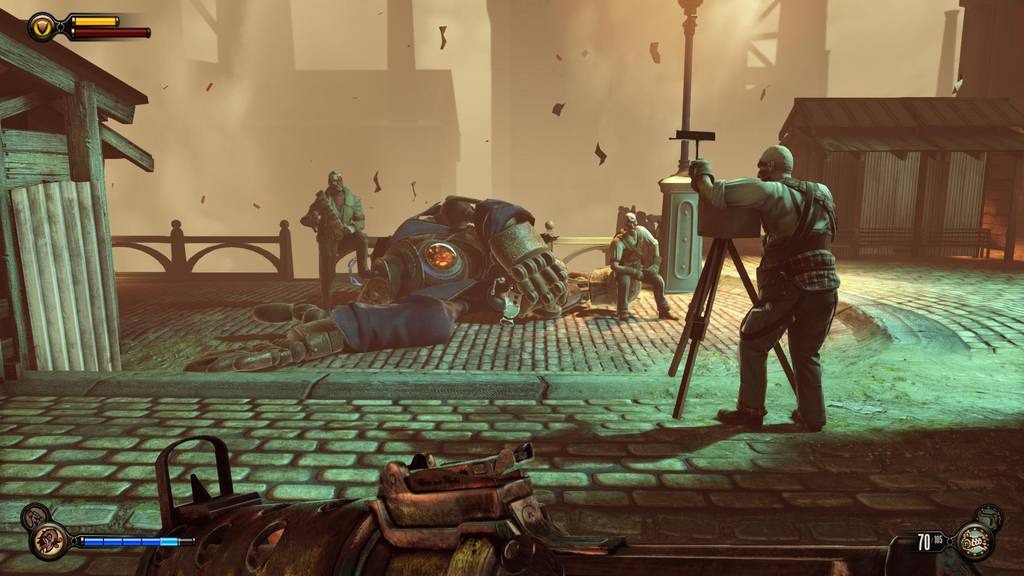
Side characters help give you some insight into Infinite’s backstory and build up the lore. Cornelius Slate is an old friend of Booker’s from his time in the army. He will help you get acquainted with the protagonist. Jeremiah Fink is a big businessman, one of the richest people in Columbia. He will show you the oppression that the people are experiencing at the hands of the powerful. Daisy Fitzroy is the leader of the Vox Populi movement. She will help you start the revolution by liberating the people of Columbia. Comstock is the Prophet, the supreme leader of the city, who controls everything. Although he might come off as comically malicious at times, when you reach the end of the road, everything starts making sense.
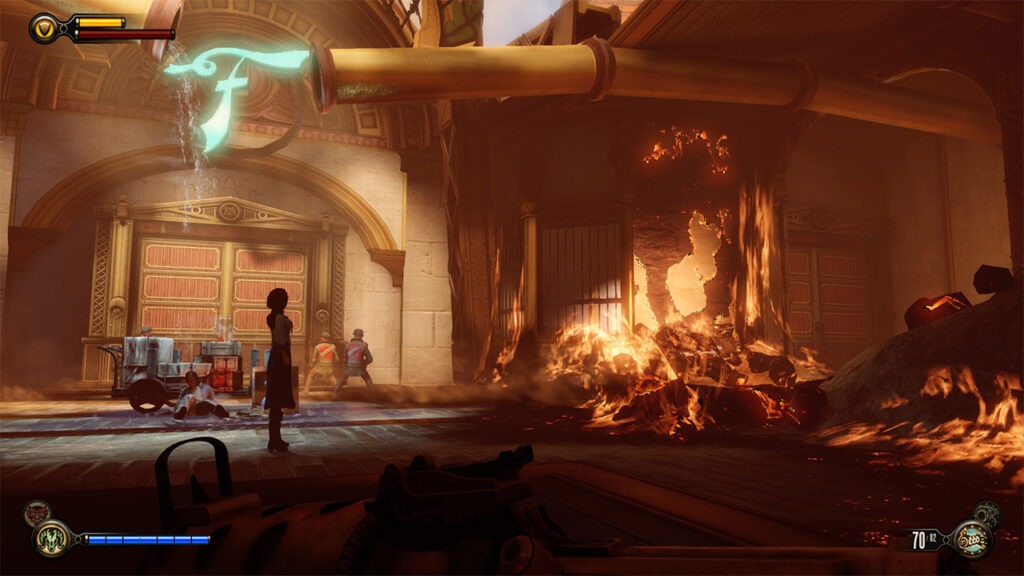
The characters and dialogues are extremely well written. Ken Levine managed to outdo himself with BioShock Infinite. This game gives you nothing less and nothing more than what you need to see and do. You only see the characters as much as you need to, enough to understand what role they play and not enough to get bored of them. But you can always learn more about them from the audio logs scattered throughout Columbia.
What about the gameplay?
Enough about the plot, the narrative contexts, and the art design, but without good gameplay, the game would be incomplete. Let me tell you, Infinite does not fall short in this area either. Gun-play is fun, with each weapon serving a specific purpose. There’s not a huge selection of weapons but each one forces you to adjust your play style accordingly. You can only carry two weapons at a time. Thus, the game puts a cap on how strong you can be. There are upgrades that you can find by exploring the world, either in the form of “clothes” or as plain stat boosts. Of course, enemies increase both in strength and numbers as you progress.
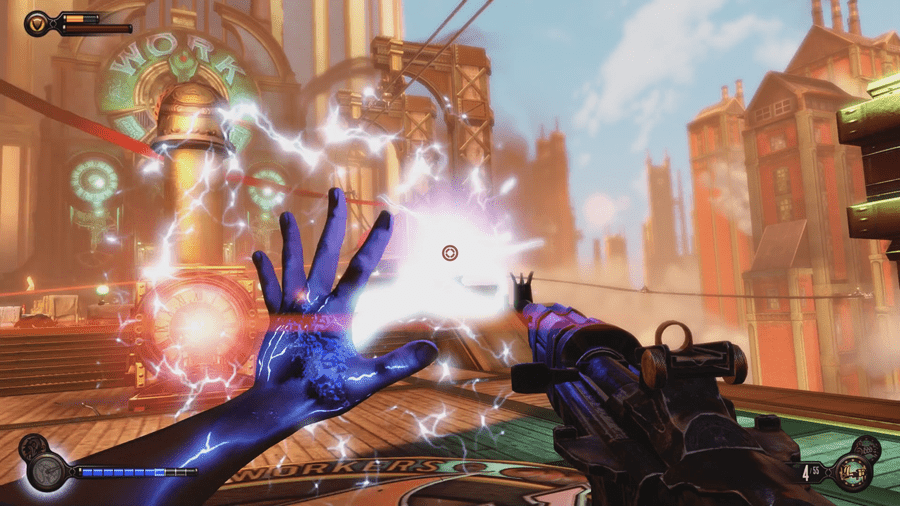
The system introduced the first BioShock, with a gun in one hand and a Plasmid in the other, is at its best in Infinite. Vigors replace Plasmids, but they work in very much the same way. Combining Vigors with regular weapons is the most satisfying thing in the core gameplay loop. It can lead to some very interesting results, where you just force push the enemies off the edge of the flying city. It can make you feel extremely strong. In some of the biggest fights, the action can get really wild.
It feels fresh
Another great addition to the Infinite is the Skyhook and the air rails you can hook onto. It gives a completely different dimension to the shooting galleries and fits perfectly with the flying city bit. Giving you the opportunity to make some spectacular aerial attacks. Or narrow escapes just before your HP hits zero.

What makes the gameplay different from the previous titles in the series, however, is that you do not fight the hordes of enemies alone this time. Elizabeth sits behind a cover and throws ammunition at you every now and then. Money, healing tonics, salts, she tries her best. You may not be the one-man army you were in the previous BioShock games, but that’s not a bad thing. It gives you the feeling that you have allies on the battlefield, while at the same time it makes Elizabeth look way cooler, when she saves your ass.
So should I play BioShock Infinite?
Without a second thought. BioShock Infinite is one of the best experiences I have ever had in gaming. The story is incredibly engaging, characters are charismatic and the BioShock world is very charming. Definitely, one of the games that when you play it for the first time you think to yourself “why hadn’t I played this earlier?”. The accompanying Burial at Sea DLC offers an opportunity to return to the underwater city we fell in love with in the previous two games.
What really intrigued me about Infinite is that it never loses its focus. It tells a very specific story, and it does so perfectly. It’s not an open-world game packed with a thousand little things to distract you. It does not have any side quests because the main story is of high quality and satisfactory in duration. Irrational Games perfectly understand the “strengths” of their game and do not bite off more than they can chew.
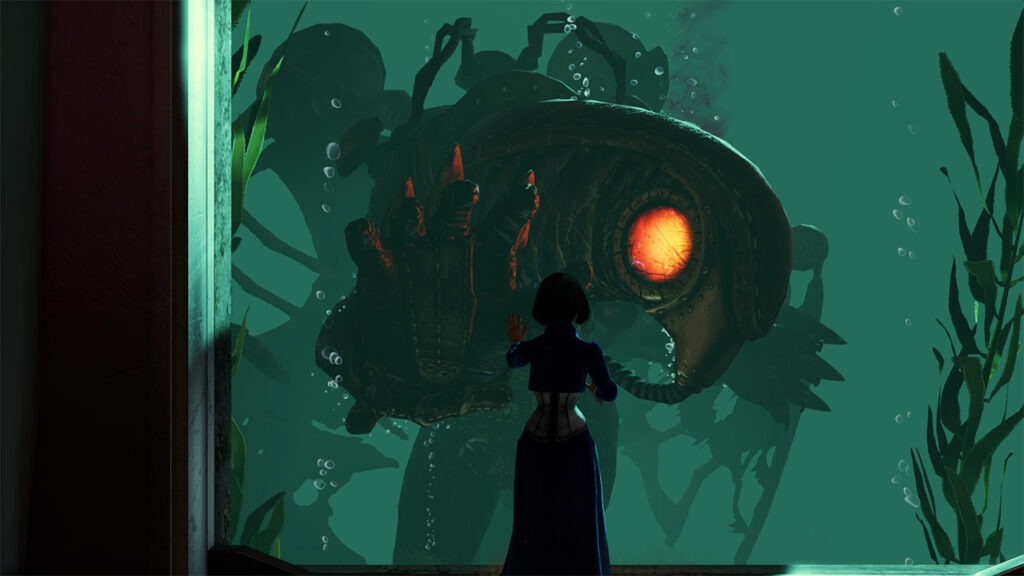
One might say that this “on-the-rails” experience takes away the user’s choice. There’s nothing wrong with that in my opinion. Not all games are meant to be the same. In the modern chaos of the gaming industry, where every title tries to do the same thing with a different approach, we need more titles like BioShock Infinite to remind us that the old, classic recipe for polished gameplay and an engaging story rarely misses the mark.
Note: The screenshots in this article are not mine, as the BioShock Collection on your Xbox removes the ability to take screenshots. The sources are in the links below the galleries.



